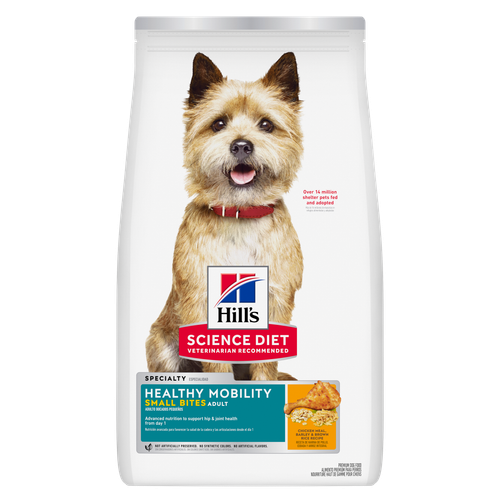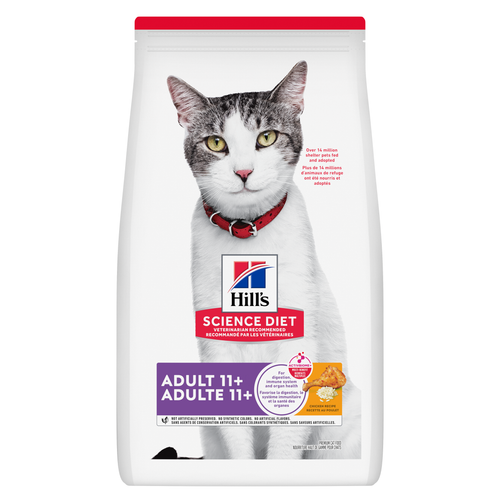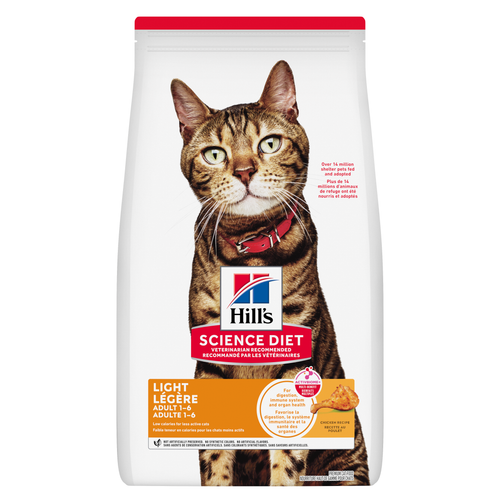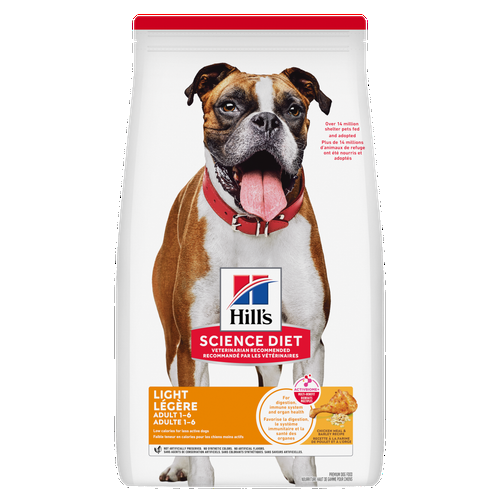
-
Find the right food for your petTake this quiz to see which food may be the best for your furry friend.Find the right food for your petTake this quiz to see which food may be the best for your furry friend.Featured products
 Adult Sensitive Stomach & Skin Small & Mini Chicken Recipe Dog Food
Adult Sensitive Stomach & Skin Small & Mini Chicken Recipe Dog FoodHill's Science Diet Sensitive Stomach & Skin Small & Mini dry dog food is tailored nutrition for Small & Mini dogs while being gentle on stomachs. Nourishes skin & promotes a lustrous coat.
Shop Now Adult Healthy Mobility Small Bites Chicken Meal, Barley & Brown Rice Recipe Dog Food
Adult Healthy Mobility Small Bites Chicken Meal, Barley & Brown Rice Recipe Dog FoodAdvanced nutrition to support hip & joint health from day 1
Shop Now Adult Light Large Breed Chicken Meal & Barley Recipe Dog Food
Adult Light Large Breed Chicken Meal & Barley Recipe Dog Food18% lower calories vs. Science Diet Large Breed Adult
Shop NowFeatured products Adult Healthy Cuisine Seared Tuna & Carrot Medley Cat Food
Adult Healthy Cuisine Seared Tuna & Carrot Medley Cat FoodDelicious seared tuna paired with tender carrots in a mouthwatering sauce
Shop Now Adult 11+ Chicken Recipe Cat Food
Adult 11+ Chicken Recipe Cat FoodSupports brain health & beautiful fur. Helps keep immune system, heart & kidneys healthy.
Shop Now Adult Light Chicken Recipe Cat Food
Adult Light Chicken Recipe Cat Food20% lower calories vs. Hill's Science Diet Adult
Shop Now -
Dog
- Dog Tips & Articles
-
Health Category
- Weight
- Food & Environmental Sensitivities
- Urinary
- Digestive
- Joint
- Kidney
- Dental
- Cancer
-
Life Stage
- Puppy Nutrition
- Adult Nutrition
- Senior Nutrition
Cat- Cat Tips & Articles
-
Health Category
- Weight
- Skin & Food Sensitivities
- Urinary
- Digestive
- Kidney
- Dental
- Stress
- Cancer
-
Life Stage
- Kitten Nutrition
- Adult Nutrition
Featured articles Importance of DHA in your Pet's Food
Importance of DHA in your Pet's FoodLearn about DHA, Docosahexaenoic Acid, a natural omega-3 fatty acid that is essential in the development of the brain and nervous system in cats & dogs.
Read More Antioxidants
AntioxidantsUnderstand the importance of antioxidants in your dog or cat's food, and how they can help protect your pet and keep them healthy.
Read More Water
WaterDiscover why water is the most important nutrient for your dog or cat to live a healthy life. Find out how much water your pet should consume each day.
Read More -


Though you're likely aware of how common breast cancer is in humans, you may not know how common breast cancer in dogs is. One in four intact (not spayed) female dogs will be diagnosed with malignant mammary tumors, according to Animal Hospital Maple Orchard, and, as with humans, early detection is key.
How Common Is Breast Cancer in Dogs?
Mammary tumors are one of the most common tumor types seen in female dogs and are the most common tumor in intact female dogs. Around 50% of dog mammary tumors are benign and 50% are malignant or cancerous, noted the American College of Veterinary Surgeons (ACVS).
Middle-aged and older female dogs are most commonly affected, and an increased incidence of mammary tumors in certain breeds suggests a genetic component, much like in humans. A few of the breeds at increased risk of malignant mammary tumors include German shepherds, cocker spaniels, Dobermans and poodles.
How Can You Catch Signs of Mammary Tumors Early?
To catch tumors early, you can start regularly monitoring your dog for any mammary growths when they're around 5 to 6 years old. If a female dog is intact or was spayed later in adulthood, she's considered at higher risk for mammary cancer; however, this regular monitoring should be done in all female dogs as a precaution.
Normal mammary tissue should be soft and pliable without any firm lumps. If you feel any lumps during an at-home assessment, take your dog to your veterinarian to discuss further testing and possible removal. In many cases, your dog may otherwise appear healthy and happy despite a palpable mammary tumor, but it's still important to have them evaluated by a vet because catching cancer early is essential.
How Is Breast Cancer in Dogs Diagnosed?
The three most important factors to determine a prognosis are mammary tumor size, lymph node involvement and metastasis (whether the cancer has spread to other sites).
In general, large tumors and cancer that's spread to lymph nodes or other organs lead to a poorer prognosis. Additional factors that can negatively affect prognosis include the presence of skin ulceration, cancer that's invasive/attached to adjacent tissue or rapidly growing, and a higher clinical stage at the time of diagnosis. According to NC State Veterinary Hospital, carcinoma tumors are one of the most common mammary cancers seen in dogs, which includes many subsets that all behave slightly differently.
A cytology exam (the evaluation of a sample of cells) of the tumor can help your vet to identify non-mammary tumors, as it allows them to see other tumor types in this location. Unfortunately, cytology alone is generally not helpful in determining whether a mammary tumor is benign or malignant, so a biopsy is often required to obtain a diagnosis.
In many cases, the surgeon will attempt an excisional biopsy (complete removal of the tumor), which can result in a diagnosis and potentially a cure in one surgery. Sometimes, additional surgeries are needed for complete removal.


Tasty Tips
How Is Breast Cancer in Dogs Treated?
Complete surgical removal is the most common treatment for breast cancer in dogs and, if accomplished, is usually curative. However, it's important to stage the tumor prior to removal to evaluate if it has spread to other organs or lymph nodes. If metastatic spread is present, then surgery isn't generally recommended unless it will help your dog's overall comfort.
Radiographs (X-rays) of the chest are performed to evaluate for any spread to the lungs, and in many cases, abdominal ultrasound and collecting cells from lymph nodes for evaluation are also performed. Unfortunately, approximately 50% of diagnosed mammary tumors are malignant, according to the ACVS, which is why early detection is key.
Chemotherapy is commonly used to attempt to delay progression in cases of aggressive mammary cancer, and radiation is sometimes used in cases when completely removing a tumor may not be possible. Medications recommended by your veterinarian may be recommended to help manage the mammary tumor or provide pain relief.
The overall goal of any treatment is to increase comfort and quality of life for your dog and to give you more time with them.
How Can You Prevent Malignant Mammary Tumors in Dogs?
The good news is that the risk for breast cancer in dogs can be significantly reduced. A study published in the Journal of the National Cancer Institute showed that spaying prior to the first heat cycle reduces risk to 0.5%, and spaying after the first heat only increased risk to 8%. However, after two heat cycles, the protective effect of spaying isn't seen, and the risk increases to 26%, likely because the female hormones have already had their effect on the mammary tissue. So, you can eliminate or greatly reduce breast cancer risk by spaying your dog either prior to their first heat or after one heat cycle.
Since female hormones play a role in mammary tumor development, spaying at any age is a helpful tool in mammary tumor prevention, although the risk benefit is not as great as discussed in the previous paragraph. In addition, dogs who are overweight during puberty are at an increased risk for malignant mammary neoplasia, so maintaining a healthy weight is also important.
As in humans, early detection is key, so regularly monitoring your dog for mammary tumors and visiting your vet if you notice anything abnormal is important. Your vet can help answer any questions and guide you in making the best plan for your dog when dealing with mammary tumors or other health concerns.


Jessica Seid is an emergency veterinarian practicing in the New England area. She is a graduate of the North Carolina State College of Veterinary Medicine and has been in the field for more than a decade. When she's not helping patients, she enjoys spending time with her husband, daughter and French bulldog.
Related products

Hill's Science Diet Sensitive Stomach & Skin Small & Mini dry dog food is tailored nutrition for Small & Mini dogs while being gentle on stomachs. Nourishes skin & promotes a lustrous coat.

Advanced nutrition to support hip & joint health from day 1

18% lower calories vs. Science Diet Large Breed Adult

18% lower calories vs. Science Diet Adult
Related articles

Learn basic steps & precautions for treating a cut on your dog, including what you can put on the cut, and when you should take them to the vet.

Your dog's coat and skin are a big part of your dog's overall health. Ensure you keep your dog's coat healthy, by following these simple tips.

Discover how the field of dog science is giving us more and more insights into the inner workings of our furry best friends.

Learn how dogs with sensitive skin can have special dietary needs, how they can develop over time in a healthy dog, and how Hill's dog food can help.

Put your dog on a diet without them knowing
Our low calorie formula helps you control your dog's weight. It's packed with high-quality protein for building lean muscles, and made with purposeful ingredients for a flavorful, nutritious meal. Clinically proven antioxidants, Vitamin C+E, help promote a healthy immune system.
Put your dog on a diet without them knowing
Our low calorie formula helps you control your dog's weight. It's packed with high-quality protein for building lean muscles, and made with purposeful ingredients for a flavorful, nutritious meal. Clinically proven antioxidants, Vitamin C+E, help promote a healthy immune system.

